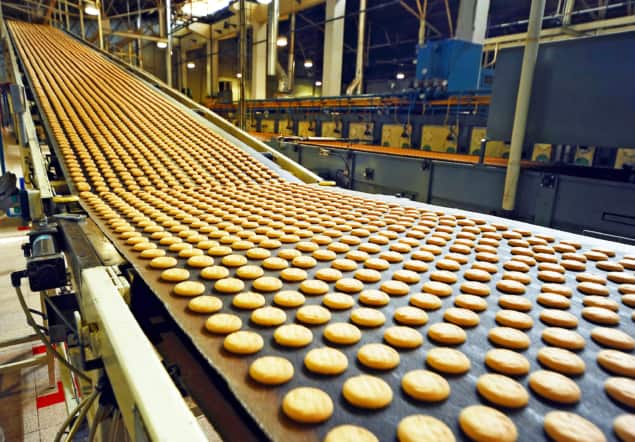
The food and drink industry is the biggest manufacturing sector in the UK, accounting for around one-fifth of manufacturing turnover – more than automotive and aerospace combined. Yet the industry globally is faced with systemic and complex challenges, not least the growing demand from policy-makers and public for a more sustainable food system that makes better use of water, raw materials, energy and land.
And that’s just for starters. Throw in the obesity epidemic, the backlash against food-packaging waste, concerns about food safety and traceability, and it’s clear that the answers to these problems are going to require long-term investment, joined-up strategic thinking, and multidisciplinary collaboration across all the levels of the food industry supply chain.
Physics, it seems, has a pivotal role to play in elaborating some of those answers, judging from the collective conversation at last week’s Physics in Food Manufacturing Conference at Campden BRI, a food-science research and training centre in the UK.
“When physics and physicists are involved in solving the inherently multidisciplinary science and technology challenges in food manufacturing, we generate new approaches for compelling product innovation – reducing costs and time-to-market along the way,” explained John Bows, R&D director at PepsiCo Global Snacks in Leicester, UK, and also chair of the Physics in Food Manufacturing (PiFM) group of the Institute of Physics (IOP), which organizes the conference.
Those multidisciplinary challenges range from designing safe, nutritious and great-tasting food to the process technology and manufacturing know-how needed to deliver such innovation. “The critical enabler,” said Bows, “is the emerging academic/industry networks that we are initiating and strengthening through the activities of the PiFM group – and in particular through this annual conference.”

He continued: “In the three years since its formation, the PiFM group has created an incredible number of touch-points, connections and networks between physicists and the food industry, leading to new partnerships, research projects and early-years careers outreach. We have a great mix of academia and industry involvement and will continue to develop these connections.”
Many of those connections were front-and-centre at this year’s conference in a diverse programme of talks and posters that pulled together the latest research on diagnostic technologies (e.g. Raman spectroscopy for food security and fraud detection), measurement quantification (e.g. hyperspectral imaging to map food composition), as well as the applications of ultrasound in food processing (e.g. to control fat crystallization and structuring).
Physical and data modelling of foods was another prominent thread, ranging across fundamental mesoscale studies (at the length scales of colloids, polymers and bacteria) to understand complex soft and active materials; computer simulations that use the lens of soft-matter physics to develop cheaper snack products for emerging markets; and modelling the release of active molecular, oligomer and polymeric species during coffee brewing.
Building the pipeline
Beyond research and application, another big driver of the PiFM conference is careers and professional development – and how to build a sustainable pipeline of top physics talent into the food manufacturing industry.
“With a background in physics, I recognize the value that physicists can bring to our industry,” explained Martin Whitworth, principal scientist at Campden BRI and a member of the PiFM organizing committee. “A key need of the food manufacturing companies is for good scientific and technical staff, so we are keen to raise awareness among physicists that there are interesting careers to be had in the food industry.”
To this end, the new PiFM careers panel provided an opportunity for delegates to examine those pipeline issues in the round, with the discussion framed by representatives from coffee company Jacobs Douwe Egberts, multibillion-dollar snack company Mondelēz, Campden BRI and the University of Leeds School of Food Science and Nutrition.
Whitworth added: “Once physics academics, especially PhD supervisors, understand how interesting and non-trivial the physics underpinning many food manufacturing challenges is, then we see uptake of early-career researchers addressing those challenges – from generating new foundational scientific capability to solving specific industry problems. The careers-panel discussion was a useful one in this regard and we’d like to run something similar again next year, guided by the delegate feedback we receive.”
Yan Wong, an applications specialist at advanced instrumentation maker Renishaw, agreed: “I enjoyed the range of high-quality talks at PiFM – largely novel research with direct application to food manufacture – while the careers panel provided lots of good personal insights into the future of food research. Beccy Smith from Mondelēz was a great example of balancing family life with a successful scientific career, while Arwen Tyler from the University of Leeds shared the importance of social media in the context of scientific networking.”
Building momentum
For other delegates, your correspondent included, it was the event’s cross-disciplinary menu of physics research and application that most caught the eye. “As a first-time attendee, the PiFM meeting surprised me as to the extent that physics is now present in food applications,” noted John Gilchrist, technical director at Camlin Photonics, an optical spectroscopy and hyperspectral systems manufacturer.

The journey of a crisp
He added: “Physics can be used to optimize manufacturing processes with appropriately robust modelling, while optical and acoustic inspection techniques provide valuable information on process performance and efficiency – ultimately helping manufacturers to improve their profits.”
For Bows, as head of the PiFM group, the conference is all about building momentum and strengthening partnerships across the food industry, food researchers and physics academia to address those long-term sector challenges. “A priority for the PiFM group this year is stronger outreach and continued connectivity to other professional-body food groups, food sector stakeholders and national funding bodies, with the aim of raising awareness of food and drink manufacturing challenges and opportunities for physics and physicists to engage,” he concludes.
- The Institute of Physics has produced a report on The Health of Physics in UK Food Manufacturing



